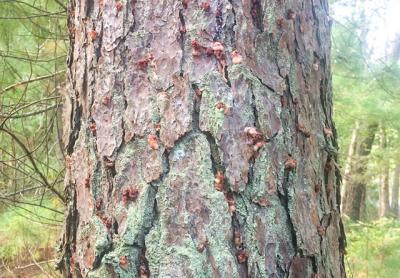Pine Pest on Killing Spree Here

The southern pine beetle, which decimated pine forests in the southern United States and New Jersey before spreading to Long Island’s pine barrens, has reached East Hampton and devastated a six-acre portion of woodland in Northwest owned by the county and town.
“Basically every pitch pine tree within the area” is infested with beetles, said Andy Drake, an environmental analyst for the town, who delivered the unwelcome news to the town board at a meeting on Tuesday. Some 800 trees are affected, he said. “These trees are going to die.”
The property is on the north side of Swamp Road between its intersections with Route 114 and Two Holes of Water Road.
Long Island’s core pine barrens to the west of East Hampton Town, including in Southampton and Brookhaven Towns, have been “pretty severely affected” by the southern pine beetles, said Mr. Drake. There was a small previous infestation in East Hampton, of about 10 trees also off Swamp Road, but it “fizzled out,” he said.
The small beetles tunnel under the bark of all kinds of pines, as well as hemlocks and spruce in heavily infested areas. Hardwood trees are not affected. The tunneling blocks nutrients to the tree and can cause trees to die in two to four months.
Native to the southeastern United States, the beetle has been expanding its range, as a result, it is believed, of warming winter temperatures, and was first found in New York three years ago in other areas of Suffolk County.
According to the New York State Department of Environmental Conservation, the beetle “can persist for years at very low numbers, sometimes going unnoticed.” Depending on conditions — natural enemies, changes in climate, types of fungus present, and the health and density of pine stands — southern pine beetle populations can explode, causing widespread tree mortality.
Signs of an infestation include pitch tubes, or clumps of resin present on the exterior of the bark, shotgun-patterned holes in the bark and S-shaped tunnels beneath it, and dead pines with reddish-brown needles.
Stands of dead trees are clearly evident in aerial photographs; a D.E.C. photo sent to East Hampton Town alerted the Department of Land Management to the beetle infestation here, and about two weeks ago staffers walked and flagged the affected property, Mr. Drake said.
The most cost-effective way to manage an infestation, he said, is to cut down affected trees and split them open, exposing overwintering beetles to predators and the winter cold.
The work should be done before spring, when beetles exit their host trees and look for new hosts. A cycle of egg-laying beneath tree bark, hatching, and vacating trees to infest new hosts can take place three times during a season, Mr. Drake said.
The estimated cost to take care of the affected area is $80,000. Up to $75,000 in New York State grant money is available for southern pine beetle management, and Mr. Drake is preparing an application to be submitted next week.
If approved, it would authorize work to commence after Jan. 19, 2018. The town would have to contribute $16,000 to the cost.
Supervisor Larry Cantwell and Town Councilman Peter Van Scoyoc both questioned Mr. Drake about whether more immediate action is warranted to contain the pine beetles’ spread. The environmental analyst will keep tabs on the situation and advise them.
“We’re lucky in the fact that it hasn’t actually crossed Swamp Road,” said Mr. Drake on Tuesday. One tree on the south side of the road was found to have southern pine beetles, but was taken down by the Highway Department and chipped. “Hopefully it’s contained until we can manage it,” said Mr. Drake.
There is good news regarding another threat to East Hampton’s trees, this time the oaks. The D.E.C. had issued warnings about oak wilt disease, a fungus spread by beetles and through tree roots underground, and instituted a quarantine surrounding Suffolk barring the transport of wood after 15 trees were found in New York with the infectious disease, including one in Southold and another in Wading River. However, recent surveys found no new infected trees on Long Island this year.
